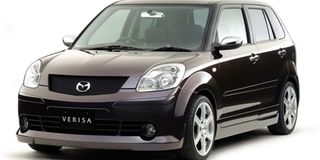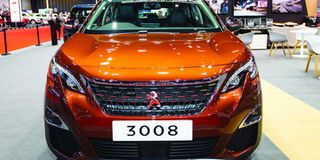Premium
I’m eyeing the Mazda Verisa, what can you tell me about it?

Mazda Verisa.
What you need to know:
- When an engine is too small (say, like 1.0 litre or below), its fuel economy advantage is nullified by the fact that you have to work it harder to keep up with more powerful traffic.
- So it ends up consuming more per kilometre, compared with something a bit more powerful.
- Do not use town cars for off-road applications.
Jambo, motoring guru,
I have been going through your work over the years and have not come across a review of the Mazda Verisa. I am planning to buy my first car soon and, and after considering many options for hatchbacks, I settled on this vehicle because it is more spacious, compared to its sister, the Demio, and understandably, its affordable maintenance. It’s a 1500cc engine capacity vehicle.
To my questions:
1. How is its fuel consumption, given that I will use it mostly in town, and off-road once in a while on Embu’s rugged terrain?
2. Are its spare part easily available?
Please add any other interesting information about the vehicle because I believe it will be the first time you will be extensively reviewing it.
Nyaga
Hello Nyaga,
Here are a few rules of thumb:
1. Any engine of 2.0-litre capacity and below is not thirsty. High consumption in such just means the driver needs to improve his or her driving. Sure, the smaller the engine, the less fuel it will burn, but we will be getting into hair-splitting territory, whereby whatever savings you derive from 100cc here or there can easily be nullified by an injudicious prod of the right foot.
Besides, when an engine is too small (say, like 1.0 litre or below), its fuel economy advantage is nullified by the fact that you have to work it harder to keep up with more powerful traffic, so it ends up consuming more per kilometre, compared with something a bit more powerful.
2. Performance cars are the exception to Rule 1 above.
3. Do not use town cars for off-road applications, however slight the off-roading might be, or else you will become a repeat customer of these very pages. There is a relatively new class of vehicles called the crossover, which tries to straddle both worlds, though how convincingly they do it varies from car to car and depends on the severity of the dichotomy. Cars like the Nissan X-Trail, Subaru Forester and Toyota RAV4 try to do this, some better than others, but expect to pay a premium over the asking price of a small hatchback like the Verisa.
Parts availability should not be a problem.
As a car, the Verisa is not half bad, it is a lovely little thing to drive and it has some cutesy neo-Eastern European charm about its appearance. I like it. Just don’t go farming with it and you’ll be safe.
****

A Peugeot 3008 car.
You’ll enjoy driving the Peugeot, but if you plan to get one, consider these factors...
Dear Baraza,
Many thanks for your weekly articles.
What’s your take on Peugeot vehicles? Their service, maintenance and all. I’m especially interested in the 3008 with an engine capacity of 1600cc.
Maina
I am a huge fan of Peugeot vehicles when it comes to driving them: they’re sublime. Not so much when it comes to owning them, though because they can be a real pain. I know this from experience.
Luckily for you, the 3008 is a contemporary model of recent manifestation, so the years are yet to catch up with it. But then again, it is a contemporary model, so service and maintenance are likely to be complex and a bit expensive. This is not exclusive to Peugeots; it applies to all modern cars.
They are a swine to fix, both from the convoluted technology they pack and the price of this tech (case in point, a recent online article spelt out how a new Kia would cost $34,000 to repair … that is Sh3.4 million in repairs for a KIA. What about a Mercedes-Benz, then? Owning a new car means waving goodbye to the DIY-grease monkey phase of your petrolheadedness, if you ever had one to begin with.
The 3008 might be a modern car, but its interior is futuristic. There are hints of Euro-chic in the design, à la 2025AD — most of which wouldn’t look out of place in a BMW X Car. And the steering wheel is not so much a wheel as it is a lozenge.
It looks like the one in the new Ford GT, which is impossibly high praise for what is essentially yet another potato-shaped crossover-jacked-up-wagon-pretend-SUV from a manufacturer known to make cars whose doors jam during their second decade of life. I’d drive a 3008 just to sit in that interior and use that steering polygon (it really isn’t a wheel).
At 1600cc, you are looking at outstanding economy. I just hope the car has the tank to match (I am deeply unfamiliar with the spec details of modern Peugeots).
If it is anything to go by, expect the engine to develop substantially more torque than fellow 1.6 litre rivals, that has always been a Peugeot underbonnet advantage and was part of the recipe for the deep, oily thrum they emanated compared to the tinny rasp of the Japanese, or the wheezy yowl of the Germans. Even with the fear of a dearth in sheer grunt from a 1.6, rest assured that this can be assuaged by the presence of a turbocharger. Interestingly enough, this engine was developed jointly with BMW. Hmm …
I have to wrap this up by specifying that I am referring to the current model of the 3008, the one that started life in 2016, and not the previous one which looks awkward and is a remnant of the dark epoch when Peugeot had lost the plot and was manufacturing cars simply because its business licence said “Car Manufacturer”.
This is the same ignominious time period that saw Peugeot assemble terrible cars like the 1007 and the badge-engineered 4007, cars that were as awfully engineered as they were unpleasant to look at. Roll on the 3008.
****

Subaru Forester
Ask the previous owner what he did with the car
I really appreciate your response to my e-mail. I shall take your advice to heart.
I’m not sure I will participate in the TT as I’m still a novice and the Subaru Forester has issues, but I can certainly guarantee you I will be a spectator, as always.
Speaking about issues, the previous owner indicated that the car has not been on its “feet” as often as it should, despite being turbo charged. I took it out for a test run in the Kiamburing and all hell broke loose. It jerked whenever I shifted gear and produced some smoke despite buying it another power plant, changing the fuel pump and everything else I could think of under the OEM guise. At one point it came to a complete halt.
I tried doing some research and the suggestions I got involved tuning. I must admit I skipped the tuning part. Would you kindly elaborate on the tuning aspect? Will tuning solve the issue or could it be the transmission, or a far much greater problem lurking underneath? All these questions keep running through my mind and since the ‘man of the house’ has put her foot down for choosing the SF over her (pun intended) and also admittedly being broke, your advice will be highly appreciated as I sort out my finances.
Mbugua Mburu
Hello again,
Glad you were paying attention the other week. So now …
The previous owner has some answers he needs to give before you find yourself stocking up on engines like a reseller. Ask him what exactly was done to the car before selling it, so that you can undo it and have the car running as it should. He should not be afraid now, the sale has been made, so it behoves him to come clean and reveal the tinkering that led you to where you are right now.
I will not go into tuning because it is a complex subject steeped in a lot of mathematics with a splash of physics and chemistry plus a little geography — yes, in tuning you have to factor in things like altitude and barometric air pressures alongside air-fuel ratios and octane ratings. So you understand why I will not delve deeper into it. But I will leave you with this: tuning basically means reprogramming the ECU to adjust cycles, pulses, timings, air-fuel ratios and pressures in the injectors, ignition circuits and turbochargers to adjust and customise the performance characteristics of an engine. It is very painstaking work and if done wrong, will wreck an engine in short order. That is partly why not everybody does it.
Tuning is done to the ECU, which will be our first stop in the diagnostic towards establishing what is wrong with your car. You might need to find a garage big enough to have a spare SF5 ECU lying around and kind enough to use it to either eliminate or affirm the ECU (tune) as a problem. If you swap ECUs and the car runs fine then your guess will be correct: the car was tuned badly. If not, continue looking for the problem.
Once you’ve established that the tune is the problem, now you have to find a new tuner to undo the handiwork of the previous one. I know a few but I’m not allowed to plug my friends’ businesses on this page, so just ask around: “Who tunes Subarus?” and you’ll be pointed in one or two directions where we are likely to cross paths. The tuner will correct the previous guy’s mistakes (it’s almost always a guy), or install a new map of his own that will, hopefully, work right, or bring the ECU tune back to stock. I don’t know how much they’ll charge you for it. The other method is to skip the tuner part altogether and buy a new ECU, but this isn’t really necessary.
I have a guess, though. Before we vilify the previous tuner (if one even exists), I insist you ask the previous owner what exactly was done to the car. Perhaps the car was tuned right after all, but for a different grade of fuel and you might have unluckily wound up with the cactus juice that shady operators sometimes try to fob off on unsuspecting clients at the fuel forecourts, hence the problematic operation of the engine. Just don’t go rushing into buying replacement blocks until you are sure of what the problem is.
Head over to the nearest Subaru garage and begin the process …
****

A Toyota Corona Premio car
Why’s the gear acting up?
Greetings from the northern frontier,
Hell came sooner for me than I had anticipated. I finally acquired a Toyota Corona (nyoka) automatic that had gear issues.
I replaced it after purchase, but after driving for 1,200km, the gear shifts to second at 40kph after some noisy revving. Before attaining 40kph, the jerks are little, but from 40kph, it behaves normal. What could be the issue because mechanics in Mandera have no clue?
Babu
Greetings, Babu, from the city!
How is the North?
Check the level and quality of the automatic transmission fluid. If they are fine, then check that the control module is working properly. This requires an "electrician", since it is not exactly mechanical work. If the module works then …
You might need to rebuild the gearbox, which is never a good idea with an automatic. Hopefully, the problem will lie in one of the two above.




